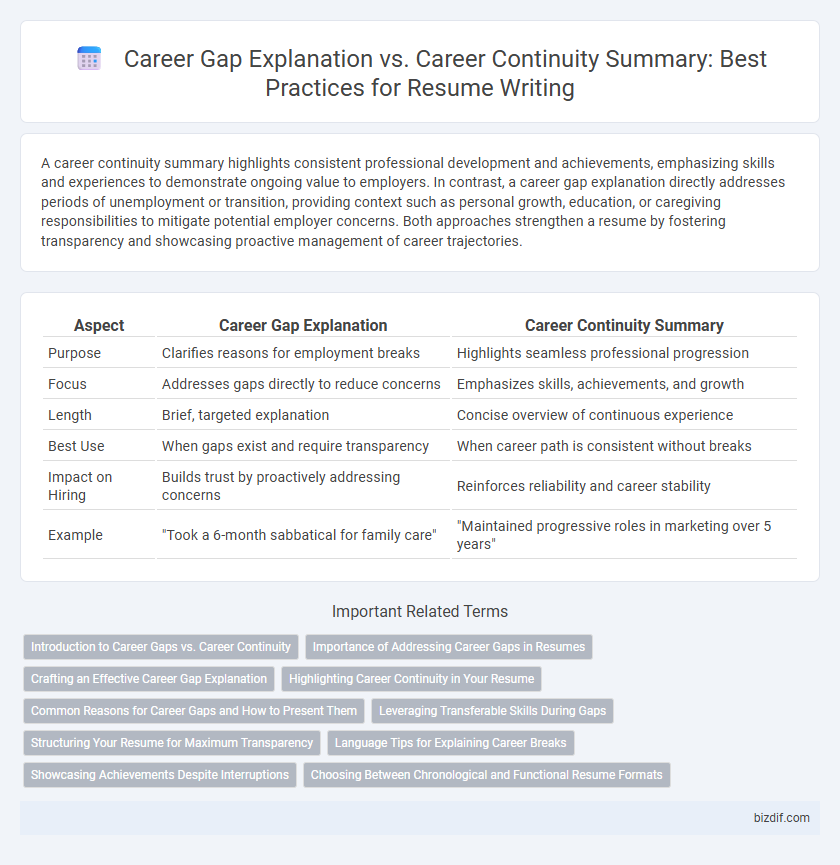A career continuity summary highlights consistent professional development and achievements, emphasizing skills and experiences to demonstrate ongoing value to employers. In contrast, a career gap explanation directly addresses periods of unemployment or transition, providing context such as personal growth, education, or caregiving responsibilities to mitigate potential employer concerns. Both approaches strengthen a resume by fostering transparency and showcasing proactive management of career trajectories.
Table of Comparison
| Aspect | Career Gap Explanation | Career Continuity Summary |
|---|---|---|
| Purpose | Clarifies reasons for employment breaks | Highlights seamless professional progression |
| Focus | Addresses gaps directly to reduce concerns | Emphasizes skills, achievements, and growth |
| Length | Brief, targeted explanation | Concise overview of continuous experience |
| Best Use | When gaps exist and require transparency | When career path is consistent without breaks |
| Impact on Hiring | Builds trust by proactively addressing concerns | Reinforces reliability and career stability |
| Example | "Took a 6-month sabbatical for family care" | "Maintained progressive roles in marketing over 5 years" |
Introduction to Career Gaps vs. Career Continuity
Explaining career gaps in a resume involves addressing periods of unemployment or transitions with clear reasons such as education, caregiving, or skill development to maintain transparency and trust. A career continuity summary emphasizes uninterrupted professional growth, highlighting consistent roles and achievements that demonstrate reliability and sustained expertise. Choosing between these approaches depends on the individual's work history and the narrative they want to present to potential employers.
Importance of Addressing Career Gaps in Resumes
Addressing career gaps in resumes is crucial for maintaining transparency and building employer trust, as unexplained gaps can raise concerns about reliability and skills retention. Providing clear, concise explanations or a continuity summary highlights proactive steps taken during the gap, such as skill development, freelance work, or education, reinforcing candidate value. This strategic approach enhances overall resume coherence and improves the chances of passing applicant tracking systems and securing interviews.
Crafting an Effective Career Gap Explanation
Crafting an effective career gap explanation involves clearly addressing employment breaks with honesty and a focus on skills development or personal growth during the period. Providing specific examples of activities such as freelance work, volunteering, or professional courses demonstrates continued career engagement and mitigates potential recruiter concerns. Highlighting how these experiences contribute to current job qualifications reinforces career continuity and positions candidates confidently despite gaps.
Highlighting Career Continuity in Your Resume
Highlighting career continuity in your resume emphasizes consistent professional growth, even during gaps, by showcasing transferable skills, freelance projects, or volunteer work. This approach reassures employers of your ongoing commitment and adaptability, framing gaps as periods of valuable experience rather than interruptions. A well-crafted summary integrates these elements seamlessly, enhancing your overall career narrative.
Common Reasons for Career Gaps and How to Present Them
Common reasons for career gaps include personal health issues, family caregiving responsibilities, further education, or job market challenges. Presenting career gaps effectively involves framing them as intentional pauses for skill development, personal growth, or necessary transitions, emphasizing continuous learning and relevant experiences gained during the period. A career continuity summary highlights transferable skills and achievements to demonstrate ongoing professional development despite breaks in employment.
Leveraging Transferable Skills During Gaps
Explaining a career gap effectively involves highlighting transferable skills gained during that period, such as project management, communication, or self-directed learning, which demonstrate ongoing professional growth. A career continuity summary emphasizes seamless skill application across roles and timeframes, reinforcing consistent competence despite employment breaks. Leveraging transferable skills during gaps showcases adaptability and readiness to contribute meaningfully in new opportunities.
Structuring Your Resume for Maximum Transparency
Structuring your resume for maximum transparency involves clearly addressing career gaps and emphasizing career continuity through a well-crafted summary. Including a concise career gap explanation within the resume or cover letter demonstrates honesty and mitigates potential employer concerns. Highlighting consistent skills development and relevant experience in a career continuity summary strengthens your professional narrative and maintains recruiter engagement.
Language Tips for Explaining Career Breaks
Use clear, positive language to frame career gaps as purposeful breaks for skill development or personal growth, avoiding negative terms like "unemployed." Highlight transferable skills acquired during the hiatus, such as volunteer work, freelancing, or education, to demonstrate ongoing professional engagement. Employ concise, confident phrases that focus on how the break enhanced your qualifications, ensuring the explanation integrates smoothly into your overall career narrative.
Showcasing Achievements Despite Interruptions
Effectively addressing career gaps involves candidly explaining the reasons while emphasizing skills gained or projects completed during the interval. Crafting a career continuity summary highlights consistent professional growth by focusing on key achievements and measurable outcomes, reassuring employers of ongoing competence. Demonstrating productivity despite interruptions strengthens a resume, showcasing resilience and dedication to career advancement.
Choosing Between Chronological and Functional Resume Formats
Choosing between chronological and functional resume formats depends on how one addresses career gaps and emphasizes skills. Chronological resumes highlight career continuity by listing work history in reverse order, ideal for those with consistent employment, while functional resumes focus on skills and achievements, effectively explaining career gaps by downplaying employment dates. Selecting the appropriate format ensures recruiters understand professional strengths without being distracted by employment interruptions.
Career gap explanation vs Career continuity summary Infographic

 bizdif.com
bizdif.com